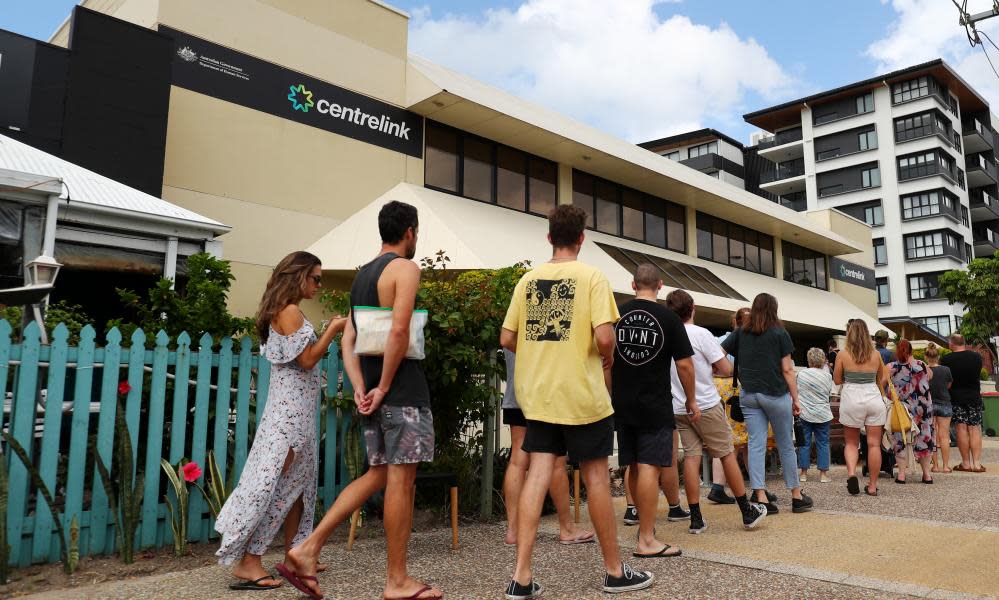Pandemic pain: Young people experiencing greater mental health distress and job losses during Covid-19

Young people experienced higher rates of psychological distress, job loss, and educational disruption during the Covid-19 pandemic than older Australians, new research has revealed.
On Friday, the Australian Institute of Health and Welfare (AIHW) released its first comprehensive report on young people since 2015, compiling the latest available data on topics including employment, education, health and the impact of the Covid-19 pandemic.
In the month after Covid-19 was declared a pandemic and the first wave of cases prompted a nationwide lockdown, young people were hit hard by job losses. Those aged 15 to 24 accounted for more than one-third (38%) of the nearly 600,000 people who lost their jobs in April 2020.
Related: Covid Delta variant is ‘in the air you breathe’: what you need to know about Sydney outbreak strain
In May 2019, 92% of young people aged 15–24 were engaged in some level of education and/or employment. This dropped by 4 percentage points by May 2020.
In May 2020, the proportion of young people who were considered not in employment, education or training was more than twice as high for those living in the lowest socioeconomic areas as for those in the highest; 18% or 96,000 compared with 8.7%, or 66,000.
“Monthly analysis since the Covid-19 pandemic began in March 2020 showed the [15-24 year olds unemployment] rate peaked at 16.4% in July 2020 and was 11% in April 2021.”
Prof Pat McGorry, a psychiatrist and director of Orygen Youth Health, said for young people it could feel like “everything is stacked against” them.
“Young people have been very neglected over the last few decades, and I think now, governments are just starting to respond, but the trouble is we’re in catch up mode,” he said.
“The drivers of the issues affecting youth are social and economic, and insecurity. This insecurity was an issue even before the pandemic. Everything is stacked against them, climate change, university fees and housing prices. My generation has really not looked after young people well.”
AIHW spokesperson Sally Mills said while the data suggests some outcomes for young people have returned to pre-Covid levels, this is not always the case.
“For example, in April 2021 the average level of psychological distress among young people was below what it was in April 2020, but still higher than in February 2017,” she said.
“Ongoing monitoring is needed to fully understand the longer-term impact of the pandemic. Adolescence and young adulthood is a critical period in a person’s life. Young people often experience rapid physical, social and emotional changes in a time where they are transitioning from dependence to independence.”
In 2020, rates of confirmed cases of Covid-19 among those aged 20–24 and those aged 25–29 – 168 and 183 per 100,000 people, respectively – were higher than all other age groups, except for those 85 years and over, with 279 cases per 100,000 in that group.
Between January and 16 June 2021, there were 187 cases of Covid-19 among young people aged 15 to 24, making up 9.7% of the total 1,929 cases during this period. In 2021, across all five-year age groups in the population, rates of confirmed cases have been highest among those aged 30–34, followed by those aged 35–39, and those aged 25–29.
The AIHW data also shows that, in the past two decades, rates of young people drinking at risky levels, daily smoking, and using illicit drugs have fallen dramatically. Overall, the proportion of young people aged 14–24 who smoke daily has more than halved, from 19.3% in 2001 to 6.8% in 2019.
Deaths among young people in Australia have also fallen across two decades, with the most recent deaths data in the report, from 2019, showing about 1,300 deaths. Injury, cancer, and diseases of the nervous system were the leading causes of death for young people aged 15–24.
“Injury remains the leading cause of death among young people, accounting for 73% of deaths in 2017–19,” Mills said. “Just over half of all injury deaths (54%) were intentional, with the remainder classified as unintentional or undetermined intent.”
Suicide prevention researcher Jo Robinson said although the pandemic had not led to increased suicide rates, “this is not the case across the entire population, with worrying trends being seen among young people and in particular young females”.
“I think taken together this suggests that we need to be continuing to protect young people from the longer term negative impacts of the pandemic,” she said.
“We are not out of the woods yet, with Covid clusters and lockdowns in several states, and no sign of a universal vaccine rollout means this is likely to continue into next year. Many young people are fatigued and we need to make sure we are looking after their emotional well being as well as their educational and financial needs.”
• In Australia, support is available at Beyond Blue on 1300 22 4636, Lifeline on 13 11 14, and at MensLine on 1300 789 978. In the UK, the charity Mind is available on 0300 123 3393 and Childline on 0800 1111. In the US, Mental Health America is available on 800-273-8255


